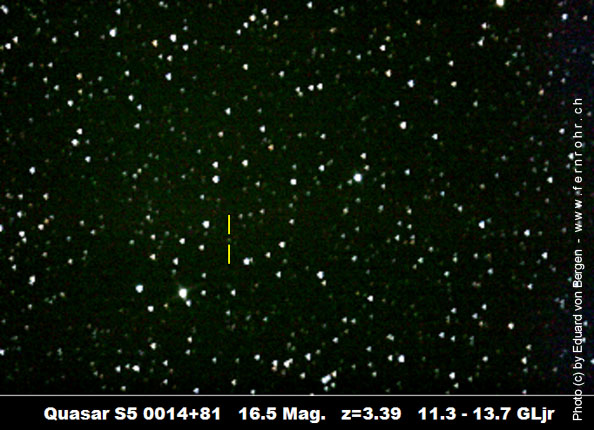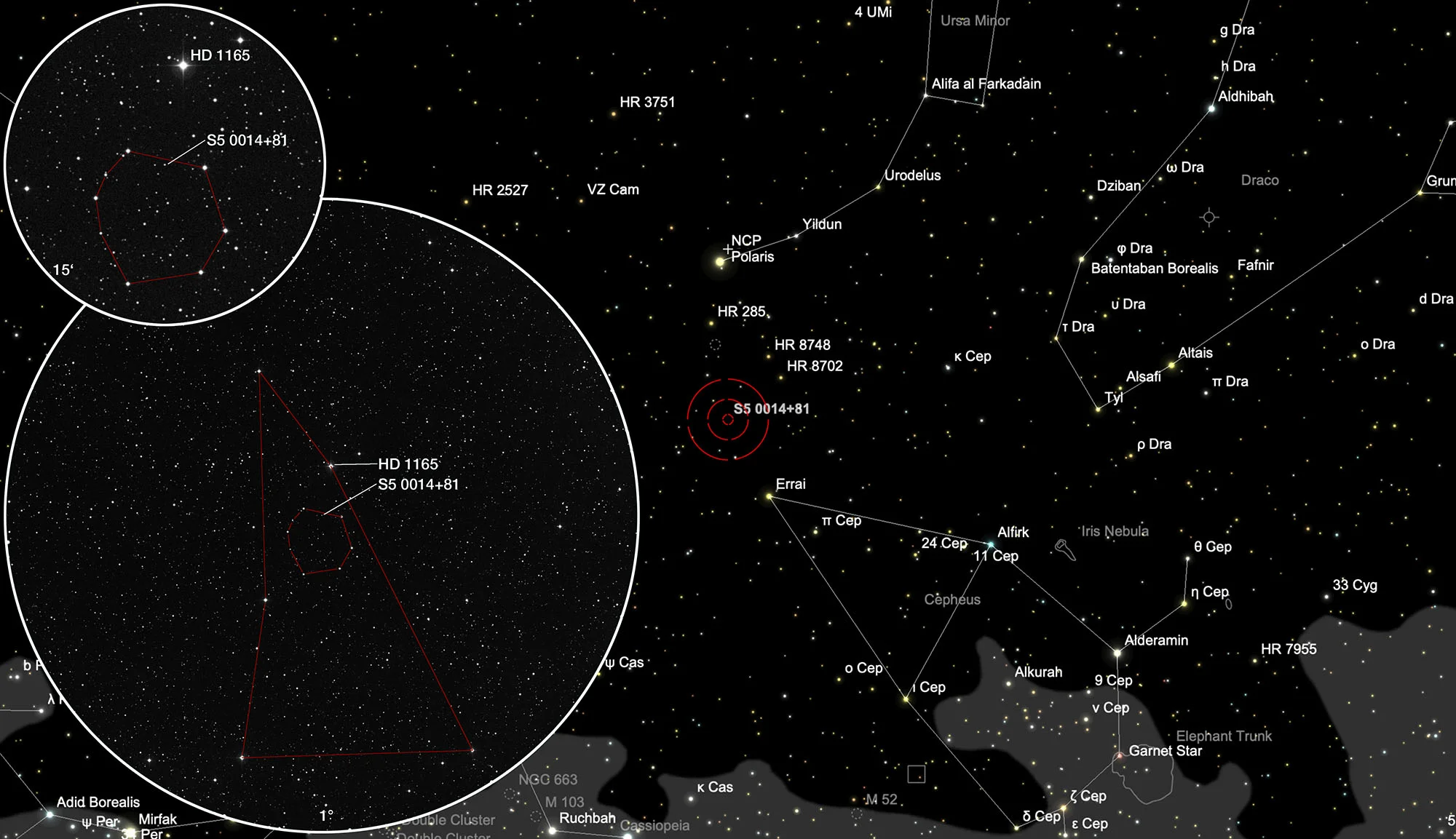Quasar S5 0014+81
Object Description

S5 0014+81 is one of the brightest known blazars, a high-energy subclass of quasars, active galactic nuclei whose collimated, relativistic particle jet randomly points toward Earth. The host galaxy is a large starburst elliptical of magnitude 24.
This quasar has a total luminosity of 1041 Watt, which corresponds to an absolute magnitude of -31.5, or 3×1014 times the luminosity of the sun. If it were 280 light-years from Earth, we would receive the same amount of energy per square metre as from the Sun — even though it would be a factor of 18 million times further away.
Due to its immense distance of 12.1 billion light years, the quasar can only be observed using spectroscopy. The responsible supermassive black hole is estimated to gobble up 4'000 solar masses of matter annually. It is a very strong source of radiation ranging from gamma, X-ray and radio waves.
The designation S5 0014+81 derives from the «Fifth Survey of Strong Radio Sources». The sequence of digits «0014+81» corresponds to the equatorial coordinates in the B1950.0 epoch: right ascension 00h 14m, declination +81°. Another common designation is 6C 001403+811827 from the «Sixth Cambridge Survey of Radio Sources», with the correspondingly more accurate B1950.0 equatorial coordinates. [145, 167]
| Name | S5 0014+813 |
| Object Type | BL Lac |
| Right Ascension (J2000.0) | 00h 17m 08s |
| Declination (J2000.0) | +81° 35' 08" |
| Parallaxes | 0.0418 mas |
| Radial velocity | 270059 km/s |
| Redshift z | 3.37781731 |
| Magnitudes | B 17.6; V 16.52; G 16.3357; R 15.95; J 14.721; H 14.124; K 13.544 |
| Identifiers | 1AXG J001720+8135; 1RXS J001710.2+813507; 2MASS J00170851+8135082; 6C 001403+811827; 6C 001409+811809; CGRaBS J0017+8135; CJ2 0014+813; CJF B0014+813; CLASS J001708.4761+813508.138; CRATES J001707+813507; Gaia DR1 566773092790942080; Gaia DR2 566773097086885888; Gaia DR3 566773097086885888; ICRF J001708.4+813508; IERS B0014+813; INTREF 9; IVS B0014+813; JVAS B0014+813; JVAS J0017+8135; KNOWS J001716+813441; KODIAQ J001708+813508; MASIV J0017+8135; MY 001403.5+811846.1; MY 001403.5+813525.7; NVSS J001708+813508; PBC J0018.3+8135; QSO B0014+81; QSO B0014+810; QSO B0014+8118; QSO B0014+812; QSO B0014+813; QSO J0017+8135; RFC J0017+8135; RORF 0014+813; S5 0014+81; S5 0014+813; SRGA J001704.0+813451; SWIFT J0017.1+8134; SWIFT J0018.8+8136; SWIFT J0018.8+8137; SWIFT J0018.9+8135; TGSSADR J001708.5+813504; TIC 468255849; WB 0013+8118; WISE J001708.50+813508.1; WISEA J001708.50+813508.1; WN B0014.0+8118; [DGT2001] B0014+813; [GCD96] 0014+81; [HB93] 0014+813; [LWT91] 0014+8118; [MGL2009] BZQ J0017+8135; [MML2015] 5BZQ J0017+8135; [S98b] 0014+813; [SRM2005] J001708.47+813508.1; [VV2000] J001708.1+813507; [VV2003] J001708.1+813507; [VV2006] J001708.1+813507; [VV2010] J001708.1+813507; [VV96] J001708.1+813507; [VV98] J001708.1+813507 |
Finder Chart
In the search for very distant objects - for example on the «edge of the universe» or better in the first hours of the formation of our universe - you will find the constellation Cepheus a quasar. On 28 September it is in opposition to the Sun and culminates at local midnight. In larger amateur telescopes the quasar S5 0014+81 should be visible with a magnitude of only 16.5. [192]
Visual Observation
350 mm aperture: With a Dobsonian of 14 inch or 350 mm lens diameter you are at the instrument limit, a larger aperture is definitely helpful. It then took about 1.5 hours until I believed my multiple short quasar sightings. With high magnifications I tried one to get as good and deep black sky background as possible. The object then also appeared occasionally for fractions of a second. In any case, a confirmation of the quasar in a larger instrument was still pending. — 14" PWO-Dobson, F:4.6 / TV-Nagler-Zoom 6mm-5mm, 266x-320x, 0.19°-0.16, Eduard von Bergen
400 mm aperture: This confirmation was achieved with a 16 inch or 400 mm Ninja Dobsonian. Even with such an instrument, the quasar was a real challenge. It showed up more often than in the 14-incher, each time flashing briefly. Averted vision and good breathing helped. In the 16 inch the perception of the quasar was clearer and more definite. We assured each other of the sighting of the quasar. Almost euphorically we switched to observing simpler and closer objects. — 16" Ninja-Dobson, F:4.5 / TV-Radian 6mm, 300x, 0.2°, Eduard von Bergen
